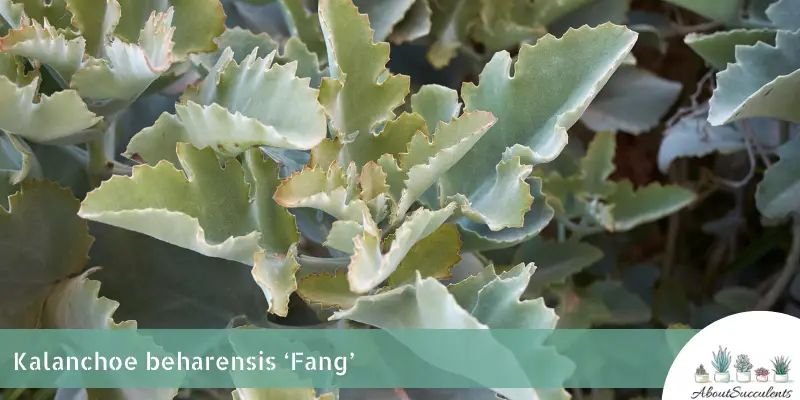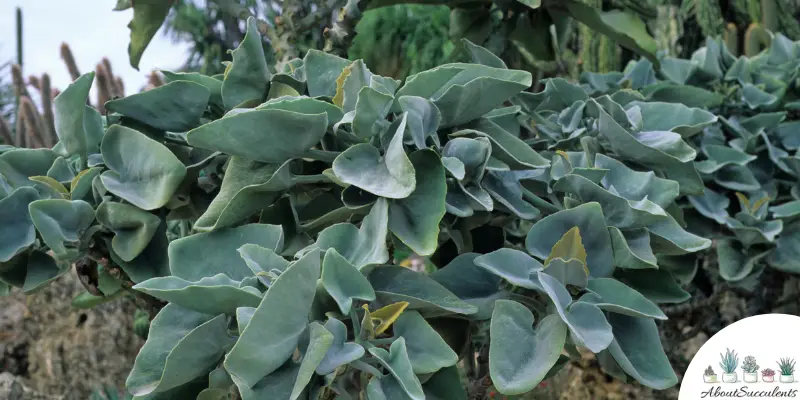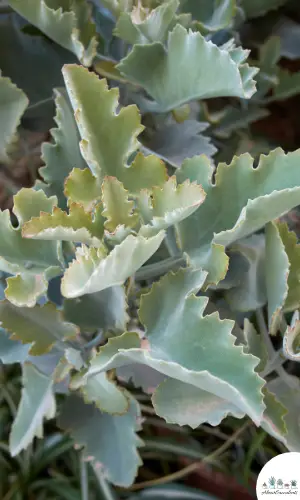
Kalanchoe beharensis “Fang” is much sought after by landscape artists because of the peculiar appearance of its leaves which have an arresting beauty about them. The leaves are arranged opposite of each other on thick, greenish-brown stems that are covered with silky, velvety gray hairs.
The triangle-shaped leaves are fleshy, measure 3.14-inches (8cm) long, are identified by irregular, jagged edges or margins, and are covered by silky, velvety, gray hairs that give it an impression of having wool.
Going back to the dark green leaves which are the main focus of Fang, its jagged margins are accented by brown spots and fold in the center to reveal a “V” like shape. On its underside, you’ll see textures that appear like teeth – the fangs – of the succulent.
Fang’s wooly countenance has also given it another nickname – Felt Plant. This is a tall succulent that can grow up to a height of 12-inches (30.5cm) with a width of 36-inches (91cm).
In the springtime, red-orange blossoms will appear. However, this might not be the case if the plant is grown indoors. The flowers aren’t particularly pretty but somehow complement its unusual features of Fang.
Kalanchoe beharensis is a member of the Crassulaceae family and is native to Madagascar.
General Information
Also known as: Fang, Felt Plant.
Plant Family: Crassulaceae
Origin: Madagascar
Height: 12-inches (30.5cm)
Exposure: Full to partial sunlight 6 hours per day but for best results, expose the succulent to full sunlight.
Water Needs: The soil must be 100% dry before watering. More frequent – 7 to 10 days during the summer – and maybe only once a month in the winter.
Soil Type: Cactus soil or commercial succulent mix with perlite, pumice, coarse sand, or lava rock for better drainage.
Soil pH: 5.5 to 7.5
How To Grow And Care For Kalanchoe Beharensis “Fang”

Kalanchoe beharensis is an excellent plant to start out with if you’re trying to earn credits for your green thumb. You can grow Fang in the outdoor garden or as a houseplant. To help Fang achieve its maximum beauty, it’s better to plant it outdoors.
One thing to remember is that Kalanchoe beharensis isn’t a cold-hardy plant. If the temperature outdoors tends to drop below 30° F (-1.1° C), it won’t survive. In this situation, it would be best to grow Felt Plant in a pot that can be transferred indoors.
Sunlight
Kalanchoe beharensis needs plenty of sunlight to remain healthy, attain its full colors, and successfully produce flowers.
As an outdoor succulent, place Fang in a location where it can receive 6 hours of sunlight on a daily basis. Avoid areas in the garden that are exposed to the harsh rays of the afternoon sun.
When growing Felt Plant indoors, look for a location where it can get partial to full sun. As mentioned earlier, this type of succulent needs direct sunlight in order to bloom.
If getting full sunlight is an issue inside your home, invest in a Grow Light and place Kalanchoe beharensis under its rays for 6 hours a day.
Watering

Succulent plants are unlike other species because they don’t require frequent watering. In fact, when it comes to giving Kalanchoe beharensis water, less is better.
If you water Fang before its soil completely dries out, its roots will rot. Before watering, inspect the soil’s moisture level which can easily be tested by inserting a stick an inch deep.
Pull out the stick and if its end feels dry to the touch, you can water the soil. Keep that last statement in mind – water the soil, never the plant.
Always give the soil a good, thorough soaking. If Felt Plant is grown in a pot, stop watering when it starts to leak out of the drain hole. Depending on the weather, the soil can dry out after seven to 10 days.
Thus, expect to water more frequently during the hot and dry months and less when the winter months have arrived.
Pot and Soil
If you’re looking to grow Kalanchoe beharensis in a pot, buy one that’s made of terracotta or ceramic, and make sure there’s a drain hole with a mesh cover at the bottom.
To properly grow and care for Fang, it’s important to dry out the soil within a few days to avoid immersing the roots in a moist environment. Ceramic and terracotta pots help the drying-out process by allowing moisture to escape from the soil faster. Make sure the ceramic pot is “unglazed”.
A commercial succulent soil mix or cactus soil will suffice for Felt Plant. To improve its drainage qualities, add materials such as perlite, pumice, lava rocks or coarse sand to the soil.
How To Propagate Kalanchoe Beharensis “Fang”
Looking to add to your collection of Kalanchoe beharensis in your succulent garden? No worries as you can propagate Fang 2 ways: Stems and Leaves.
Stem Cuttings Method
Step 1: Use a pair of sharpened and sterilized garden shears to cut off a healthy stem. Cut the stem at an angle to make it easier to plant in the soil.
Step 2: Place the stem cuttings in a dry area and give them 2 to 4 days to develop hard calluses.
Step 3: Once the calluses have appeared, plant the stem cuttings on well-draining soil.
Step 4: Lightly water and make sure the pot gets regular exposure to sunlight.
Step 5: When the roots have gained hold in the soil, only water when it’s completely dry.
Leaves Method
Step 1: Choose a healthy leaf and use the twist and pull technique to cleanly remove it from the stem. Take great care that no part of the leaf is left on the stem. Otherwise, successful propagation will not take place.
Step 2: Allow the leaves to callus over by letting it dry out for 2 to 4 days.
Step 3: When the leaves have developed calluses, place it on top of well-draining soil.
Step 4: Lightly water the soil and situate the pot in an area that gets morning sunlight for 4 to 6 hours every day.
Step 5: Once the roots have formed, only water the soil when its dryness has been tested and confirmed.
Frequently Asked Questions
Is Kalanchoe Beharensis “Fang” Toxic For Cats And Dogs?
The Kalanchoe species appears on the list of succulents that could be toxic to cats and dogs in the website of the American Society for the Prevention of Cruelty to Animals (ASPCA).
When growing Kalanchoe beharensis indoors, place it in a room that’s not accessible to your pets. Take note of symptoms such as vomiting or loss of appetite. Once you observe these symptoms, bring your pet to the veterinarian right away.
Why Is My Kalanchoe Beharensis “Fang” Dying?
Overwatering, insufficient sunlight, and pest infestation are the biggest threats to the health and well-being of your Kalanchoe beharensis.
Overwatering
A common thread in this guide to growing and caring for Kalanchoe beharensis is to avoid overwatering the succulent or keeping it under moist conditions for a long period of time.
If the roots are immersed in moist conditions, the cells could rupture and they will start rotting. The disease will find its way into the plant immediately. You’ll know for sure that Felt Plant is infected when you notice discoloration on the stems and leaves.
When you observe these signs, don’t waste a minute and cut the discolored sections with a sterilized and sharpened knife or garden shears to stop the infection from spreading.
Uproot the plant, shake off the excess soil, and cut off the roots that have decayed beyond salvation. Let Felt Plant rest and dry out in an area while you begin the process of repotting.
Fill a new pot with fresh sandy soil or cactus mix and replant Kalanchoe beharensis in its new home.
Lack of Sunlight
Sunlight is crucial for all plant life and succulents are no exception. Kalanchoe beharensis needs sunlight not just for aesthetic purposes but also to produce its food via photosynthesis.
If Fang doesn’t get enough sunlight, its leaves will stretch out as if searching for the sun’s rays. This is the phenomenon called etiolation and it will leave your plant withered and dried out.
The remedy for etiolation is quite easy. Simply place Fang in a location that gets regular morning sunlight. You’ll notice its leaves slowly get back to a healthy green color.
Pest Infestation
Succulents contain sap which pests love. The most common pests that infest Kalanchoe beharensis are aphids and mealybugs. Once drained of nutritious sap, Fang could die.
Spray Fang with a natural pesticide like neem oil to keep insects away. If you see white, cotton-like residue on the leaves of Fang, these are from the mealybugs. You can wipe them off with a cotton ball that’s soaked in 70% isopropyl alcohol.
Yes, Kalanchoe beharensis produces red-orange flowers in the springtime. The chances of a successful bloom are higher when Fang is grown outdoors.
Last Updated on June 9, 2022 by Sofia Lara